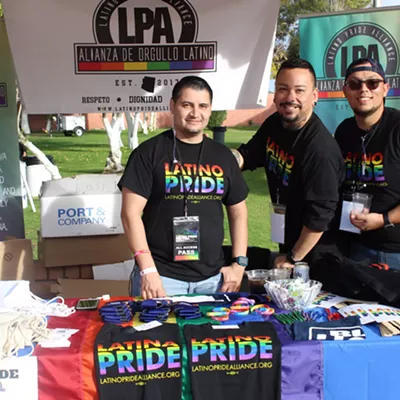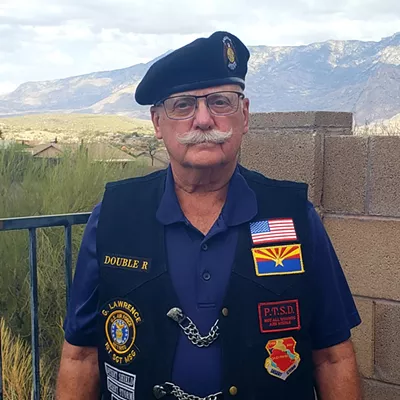In any other world, Rudy would be king, albeit a king of small and shaggy lineage. After all, he has his own cushy bed, fine food and water, and a beefy air-conditioning unit pumping cold air overhead.
But in this world, Rudy is just another shelter dog, although a very lucky one, indeed. Lying in a cage at midtown's HOPE Animal Shelter, the terrier mix is a senior citizen in the realm of dogs, with failing eyesight and questionable hearing. He's also afflicted with Cushing's disease. Caused by hormone overproduction in the adrenal glands, it can cause hair loss and a pot belly. Fortunately, Cushing's is easy and cheap to treat.
Like many HOPE residents, Rudy arrived here after his owner died, and no relatives would take him. So bringing him up to snuff fell to shelter head Susan Scherl, who quickly scheduled him for plenty of tests and medications.
Today, some $600 later, he's a cream puff. Scherl says she never turns away animals like Rudy, who she says would certainly be euthanized at the Pima Animal Care Center or the Humane Society of Southern Arizona.
But her compassion comes with a hefty price tag—and it's growing as HOPE sees more older and sicker animals, including those Scherl regularly retrieves from PACC. Her vet bills can easily top $4,000 a month.
Scherl says the economy, and the subsequent inability of folks to afford veterinary care, is causing more and more "special needs" pets to be abandoned. For shelters like hers, this means a steady struggle and constant fundraising just to keep up.
While PACC isn't necessarily seeing a spike in old and sick animals, "We've had more old dogs with minor issues that we've been able to put up for rescue and get out of here," says spokeswoman Jayne Cundy. "Which is a great thing, because we're kind of soft on the older ones."
Many of them wind up at HOPE and other shelters. But it isn't just aging animals that boost vet bills for these nonprofits. Over recent weeks, for instance, 33 kittens have been left at HOPE's front door. By the time they're ready for adoption, each will have cost the shelter roughly $300. "But they're not old enough yet to be adopted," Scherl says, "so they'll have to go to foster care. I'll have to pay for food for them, and for spay, neuter and vaccines. Since most of them were sick, they were also put on antibiotics and eyedrops."
That's just the beginning. We're sitting in Scherl's office, where she points out two older cats lounging in a cage behind us. "Sunny, who's lying on the bottom, and Samantha—they just cost me $2,000 to have their teeth done," she says.
The cats also have ongoing oral problems, including chronic ulcers, that will cost even more to fix. While many generous Tucson veterinarians offer discounted services to animal-rescue groups (though others do not), Scherl says such breaks are typically 20 percent off the total cost—not enough to keep shelters such as hers from teetering on the brink of bankruptcy.
Some professional groups, such as the American Bar Association, insist that members offer some volunteer or low-cost services as a civic duty—but the American Veterinary Medical Association apparently does not. Contacted by the Tucson Weekly, AVMA spokesman Michael San Filippo said that charitable work requires "a delicate balance" for AVMA members, "many of whom are small-business people with overhead and staffs and costs."
San Filippo promised to check on any existing AVMA charitable-work guidelines, and call us right back. That was the last we've heard from him.
Some experts call the AVMA's stance unfortunate, citing the high cost of veterinary care in tough economic times as a key reason that people abandon older and ailing animals. "This trend has definitely added to the intake at shelters around the country," says Cory Smith, senior director of the Pets for Life program at the Humane Society of the United States in Washington, D.C. "We started seeing a lot more older animals when foreclosure rates began to rise. You know there has to be a very valid financial reason for families to give up an animal that they've cared for and bonded with for so long."
While adoption rates are slowly increasing, an estimated 6 million to 8 million animals are still abandoned at shelters each year. Of those, roughly 4 million are euthanized.
While no-kill shelters such as HOPE care for animals with challenging health problems, others make the heart-rending call to put them down. "There are so many organizations struggling with where you draw that line," Smith says.
Where the vets draw the line is another matter. "There are certainly a number of veterinarians out there who do everything they can to (help) people and their pets," she says. "But due to the economy, even veterinary practices are struggling. And if they don't have a business model that's conducive to providing those reduced-cost community services, they can't do it, or they don't know how."
In response, Smith's organization is encouraging more charitable work through its Humane Society Veterinary Medical Association. The HSVMA supports issues ranging from trap-neuter-release programs for feral cats to providing affordable veterinary care for low-income folks. Its Rural Area Veterinary Services Program operates low-cost field clinics, and the association encourages innovative approaches such those used by one Richmond, Va., veterinarian, who offers steep discounts for cash-strapped clients willing to volunteer at shelters.
At the same time, Smith says, animal-welfare groups themselves are beginning to offer sliding-fee veterinary services, "because that's a need that I don't think is being met by the veterinary community."
Another increasingly common strategy to reduce pet-abandonment rates is the establishment of care networks, where folks agree to take animals on a temporary basis when the owners face financial or personal hardships, or military deployments.
But back at HOPE, where each month heralds a fresh, daunting pile of bills, animals like Rudy are lucky to be alive. Now he's tucked in his cage for an afternoon nap as Scherl contemplates fundraising letters and more wrangling with vets. While she'd never forsake pets with problems, she says, that doesn't mean these aren't white-knuckle times. "As I'm getting lower and lower on money, I'm seeing more and more of these special-needs animals."
Then Rudy stretches out and yawns deeply. The hard times are temporarily forgotten.







